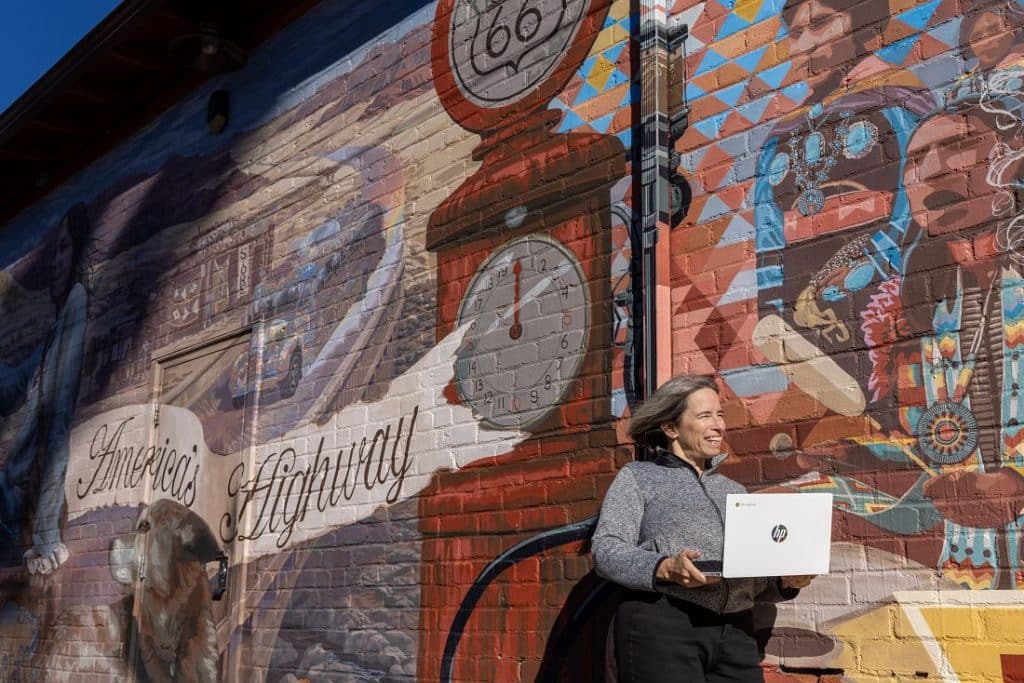Known as the “Mother Road,” Route 66 runs right through the heart of Flagstaff and is celebrated by the local tourism industry for its nostalgic value and vintage charm.
But there’s a hidden dimension to the highway’s history, and not everyone experienced it in the same way. Black, Indigenous and people of color (BIPOC) traveling along Route 66 often encountered racism and were excluded from the restaurants and motels dotting the landscape.
Through a $190,000 grant from the National Endowment for the Humanities’ Landmarks of American History and Culture, associate professor Gretchen McAllister and Ricardo Guthrie, formerly the director of NAU’s Ethnic Studies Program and now distinguished associate professor of social justice at Fisk University, recently launched a new project, “Racialized Spaces on Route 66.”
The team will create a professional development program for K-12 educators focused on the significance of race, place and movement along the highway. Their goal is to engage teachers and their students in multiple perspectives to broaden their cultural understanding of Route 66 within U.S. history.
“We’re trying to widen the narrative about Route 66, especially among teachers in areas like ours,” McAllister said. “We’re taking the typical story and looking at it through a racial lens—for example, from the perspectives of African Americans, Hispanics and Indigenous populations who came through Flagstaff and live in Flagstaff. We’re asking questions to learn how all communities, including Anglos, created different narratives about Route 66, developed ways of interacting across race and contributed to a rich, compelling history. We’re developing lessons based on stories that help illustrate that history.”
Route 66 is largely romanticized as a symbol of freedom and independence in white mainstream culture because of the economic prosperity and opportunities it brought during the mid-20th century. Stretching from Chicago to Santa Monica, Route 66 was one of the first paved national highways connecting hundreds of small towns and providing a trucking route through the Southwest.
In addition to how people in the towns and cities along the road were affected as their populations shifted in response to migration to the West, McAllister is interested in the issues of power that these stories represent. “When we’re working with kids, what is the best way to tell this history, which is sometimes difficult? It’s a lot more complex than people in Flagstaff realize—and it has a lot more voices and implications. It involves Jim Crow laws, segregation and local history that most people don’t even know about.”
Teacher education program will feature local field trips
Experts in culturally responsive teacher education, McAllister and her colleagues—including associate professor Joseph Martin and associate teaching professor Becky Pratt-Sturges—will combine virtual and residential education in a program next summer. While the teachers are on campus, the team will lead them on several field trips.
The teachers will participate in a session at Cline Library’s Special Collections & Archives. Archivist Sean Evans, an expert in Route 66 history, will share stories, voices and images of underrepresented people and communities who contributed to the diverse cultural and socioeconomic landscape featured in the online exhibit, Shades of Route 66. They will visit the Murdoch Center, where Guthrie will talk about Black history on Route 66. A tour of downtown Flagstaff will focus on stops listed in The Negro Motorist Green Book, which helped Black travelers avoid discrimination. They also will examine the exploitation of Indigenous communities through tourism as they venture to the ruins of the Twin Arrows Trading Post.
The application deadline for the Summer 2023 seminars is March 3. Museum educators and other K-12 school system personnel, such as administrators, substitute teachers and curriculum developers, are encouraged to apply at the Racialized Spaces website.
Guthrie said the project creates a unique opportunity to learn how African Americans and others turned segregation, discrimination and service into building multiracial communities of resilience.
“Because it involved people who were not just tourists, as the mythical storyline of Route 66 goes, but sojourners who came to Flagstaff and Arizona, in particular, a powerful historiography emerges,” Guthrie said. “Not just history, geography or biography, but something larger that changes the landscape we encounter in Flagstaff and all along Route 66. Black lumberjacks and millworkers, Indigenous traders, Asian laborers and Mexican/Hispanic restaurant owners—all changed how we see and understand our community, and we have some of the most vivid reminders of that unique heritage right here in Flagstaff.”
Culturally responsive lessons influence future teachers

This project has evolved from material Guthrie and McAllister developed for teacher education and Ethnic Studies courses offered by the College of Social and Behavioral Sciences and the College of Education, including EDF 484/ES 484 – Racism in U.S. Schools and Society and ECI407 – Social Studies Education.
Lani Nallira, a 2022 graduate from NAU’s College of Arts and Letters with a bachelor of science in secondary education–history and social studies who is pursuing her master of secondary education degree, now teaches history at the Flagstaff Arts and Leadership Academy (FALA). She recalls learning about the Route 66 project in Guthrie’s Ethnic Studies course, how it helped shape her perspective on local history and how what she teaches her own students is more culturally responsive as a result.
“Dr. Guthrie’s class was one of the last courses I took as a senior,” Nallira said. “I learned so much about race and the impact education has on both individuals and communities and the BIPOC community in particular. If we don’t teach the truth about racism within the context of history, students will be at a disadvantage and won’t have the representation they deserve in our society.”
Nallira uses many of the sources she was introduced to with her own students as well as in essays she writes for her graduate-level courses. She recently had the opportunity to apply her knowledge with her FALA students, many of whom are Indigenous. On Indigenous People’s Day, held the second Monday in October, she taught them the history behind Columbus and the European colonization of the Americas that brought disease, enslavement and genocide to the Indigenous people—and how it still affects their lives. At an assembly that day, students were encouraged to voice their feelings about these issues, and afterwards, Nallira gave students in her class the opportunity to compare what they’d just learned to the views they’d heard at the assembly.
“I became a better person because of what I learned at NAU,” Nallira said. “And the beauty of history is there’s so much more to learn about cultures you’re not familiar with, even if it takes you out of your comfort zone.”
Kerry Bennett | University Marketing




